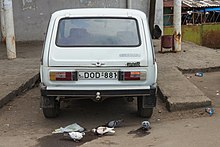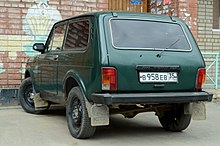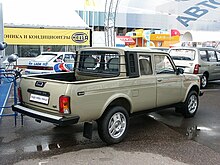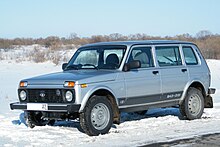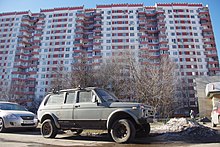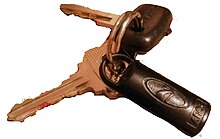WAS-2121 Niwa
| AwtoWAS | |
|---|---|
|
Niva 1600
|
|
| WAS-2121 | |
| Production period: | since 1976 |
| Class : | Off-road vehicle |
| Body versions : | Station wagon , landaulet |
| Engines: |
Otto engines : 1.3–1.8 liters (44–61 kW) Diesel engines : 1.9 liters (55 kW) |
| Length: | 3720-4240 mm |
| Width: | 1680 mm |
| Height: | 1640 mm |
| Wheelbase : | 2200-2700 mm |
| Empty weight : | 1150-1390 kg |
| Previous model | none |
| successor | none |
The ВАЗ-2121 "Нива" , German transcription: WAS-2121 "Niwa" , known under the trade names Lada Niva 1600 or Lada Niva 4X4 , is an off-road vehicle produced by the Russian automobile manufacturer AwtoWAS in Tolyatti . Model names for other markets include Lada Taiga ( Austria ), Lada Sport ( Iceland ) and Lada Bushman ( Australia ). The car is the founder of the class of compact and inexpensive off-road vehicles with a self-supporting body. This concept has been adapted by many western manufacturers. Continuously developed, the WAS-2121 has been manufactured for four decades and is considered a simple but extremely robust construction. 1,492,554 copies were produced by 2002. The car is still in production.
Vehicle history
Master model WAS-2121
The WAS-2121 goes back to the chairman of the Council of Ministers of the USSR, Alexei Nikolaevich Kosygin . In the summer of 1970 he asked AwtoWAS , ASLK and Ischmasch to develop an off-road vehicle based on the WAS-2101 for rural areas: “The cooperation with Fiat is ending (...). So, your first independent step should be the creation of an off-road vehicle based on the “ Shiguli ” for our villagers. ” The later WAS-2121 was then developed at AvtoWAS, largely under the direction of Pyotr Prusov (1942-2017). First tests with two prototypes ( 1Э2121 ) were carried out in the summer of 1971. These prototypes differed considerably from the later production model: They had a ladder frame, an open body and no lockable center differential. After these tests, the concept of the vehicle was fundamentally revised. In the summer of 1973 the second prototype 2Э2121 was completed, which was not only technically but also visually similar to the later production model. This car had permanent four-wheel drive with a lockable center differential and a self-supporting body designed by the designer Valeri Semushkin. In 1974 the prototype also had the radiator grille of the later production model. In the same year, the first 15 pre-series models were produced. The order to start series production was placed on July 15, 1975. The first vehicles of the pilot series were finally produced in February 1976, and another 50 vehicles followed in March. The basic model with a 1.57 liter engine, the WAS-2121, sales name Niva 1600 , was soon supplemented by a version with a 1.3 liter displacement, model name WAS-21211. It was only built in small numbers. The "Niwa" quickly developed into a successful model that was also exported to western countries.
New model range in the 1990s
The "Niwa" underwent the first major changes in the early 1990s. The model range was gradually revised and a wide range of vehicles based on the "Niwas" were brought onto the market. The original WAS-2121 was replaced in 1994 by the WAS-21213, which had a 1.7 liter engine, a five-speed gearbox and a larger rear door with a lower loading sill. Between 1991 and 1994 there was the transition model WAS-21219, still with the old body, but already with the new technology. Outwardly, the biggest difference between the WAS-2121 and WAS-21213 are the narrow taillights next to the tailgate that extends to the bumper instead of the wide lights on the rear panel. Furthermore, the car has a new dashboard, a new speedometer and a new steering wheel with a deformable hub (impact pot). From then on it was the basic model, all subsequent models are based on the WAS-21213. They no longer have the model name Niva 1600 . In cooperation with Peugeot, the WAS-21215 with a 1.9 liter swirl chamber diesel engine was built from 1993 . Also in 1994 followed a variant with a 500 mm longer wheelbase, initially with three doors and additional side windows. The long wheelbase model WAS-2131 has been built as a five-door hatchback since 1995. The second model with a long wheelbase and three doors is marketed as "Fora" and bears the type designation WAS-21218. It has longer doors so that there are no additional side windows. Another model is the landaulet.
Efforts were made in the 1990s to replace the “Niwa” with a modern design. The WAS-2123 was developed , which was handcrafted in small numbers. However, the turmoil in the Russian automotive industry and the financial crisis did not allow large-scale production. GM and AwtoWAS started a joint venture as GM-AwtoWAS , which ultimately marketed the vehicle as the Chevrolet Niva.
Recent developments
In the years 2009/2010 there was a general modernization of the now over 30 year old model. The dashboard, the front indicators and the technical equipment were changed. Among other things, changes were made to the front and rear suspension and the shock absorber set-up was modified. In addition, the larger exterior mirrors can now be adjusted from the inside. The door panels were also changed later. In addition, the now called Lada 4 × 4 has been delivered with ABS since 2013. and receives a KTL coating during painting .
Type overview
In the specialist literature, the vehicle is uniformly referred to as ВАЗ-2121 "Нива" , the German transcription WAS-2121 "Niwa" . Niva acts as a brand name for all vehicles based on the WAS-2121 and is also understood without the brand name of the manufacturer AwtoWAS for export markets, Lada . In the meantime, however, the brand name Lada can also be found in Russian-language specialist literature, where the vehicle is also referred to as Lada Niva in addition to the type designation WAS-2121 "Niwa" . Some Niwa types also have a trade name, the first "Niwa" is often Niva 1600 , but generally only the type designation is used as a trade name, which is applied above the sill. In some models, the addition 4 × 4 was used in addition to the trade name , which later became the trade name of "Niwas" as 4 × 4 .
Short wheelbase
-
WAS-2121: basic type, built until 1994, four-speed gearbox, carburettor engine 1.57 l displacement. Trade names and a .: Lada Niva 1600 , Lada Austro Taiga , Lada 2121 , Lada Niva 4 × 4
- WAS-21211: Like the basic type, built up to approx. 1987, four-speed gearbox, 1.3 liter carburettor engine.
- WAS-21219: Transitional model between WAS-2121 and WAS-21213, which already has a five-speed gearbox and a 1.7 liter engine, but the body still corresponds to the WAS-2121.
-
WAS-21213: basic type since 1994, five-speed gearbox, carburettor engine 1.7 l displacement. Trade names and a .: Lada Niva , Lada Niva 4 × 4
- WAS-21212: Intended for export, right-hand drive, gasoline engine, 1.7 l displacement. Trade names and a .: Cossack
- WAS-21214: Intended for export, since 1994, five-speed gearbox, intake manifold injection 1.7 l displacement. Trade names and a .: Lada Niva , Lada Niva 4 × 4 , Lada Niva 1.7i , Lada Taiga , Lada Urban , Lada Bushman , Lada Sport , Lada 4 × 4
- WAS-21215: As basic type, five-speed gearbox, swirl chamber engine 1.9 l displacement.
- WAS-21217: Intended for export, 1.3 liter petrol engine.
- WAS-2122 : Kübelwagen with chassis of the “Niwas”, carburettor engine 1.3 l displacement. Trade names and a .: Reka
- WAS-1922: Extreme all-terrain vehicle with oversized balloon tires. Trade names and a .: March
Wide wheelbase
-
WAS-21218 "Fora": three-door station wagon with long doors, 300 mm longer than the WAS-21213. Gasoline engine 1.7 l displacement
- WAS-212183: Open landaulet , 300 mm longer than the WAS-21213. Gasoline engine 1.7 l displacement
-
WAS-2129: Three-door station wagon with short doors and additional side windows, 500 mm more wheelbase than the WAS-21213
- WAS-2131: Five-door station wagon with short doors without additional side windows, 500 mm more wheelbase than the WAS-21213, also available with a 1.8-liter engine
- WAS-2131 SP: Three-door station wagon with short doors and additional side windows, ambulance
- WAS-2329 Two-door pickup truck, gasoline engine 1.7 l. Trade names and a .: Lada Niva 4 × 4 1.7i
technology
The “Niwa” is a two-axle off-road vehicle with a self-supporting station wagon body, a longitudinally installed front engine, reduction gear and permanent all-wheel drive. The following is a description of the WAS-21213-based types as of the late 1990s.
landing gear
The front wheels are individually guided on double wishbones of unequal length and have coil springs with hydraulic telescopic shock absorbers. A rigid axle is installed at the rear , which is guided on four trailing arms and a Panhard rod and is also supported on coil springs with hydraulic telescopic shock absorbers. An anti-roll bar is installed at both the front and rear. The wheels of the "Niwas" are steel disc wheels measuring 127J – 406 mm (5J – 16 in), on which tires measuring 175–406 mm (6.95–16 in) are mounted. The steering is a roller steering with globoid worm and two-ring roller that is not servo-assisted. The car has a hydraulic dual-circuit brake system with disc brakes on the front wheels and drum brakes on the rear wheels. The handbrake acts on the brake shoes of the rear wheels.
Power transmission
The torque is transmitted from the engine to the gearbox via a dry single-plate clutch . The transmission has five synchronized forward gears and one unsynchronized reverse gear. They are engaged with a central gear lever. A reduction can be activated with another lever; a total of ten forward speed levels and two reverse speed levels are available. The gearbox is connected to the transfer case via a Hardy disc (not rigid shaft coupling). The differential of the transfer case can be locked so that the front and rear axles turn at the same speed. Multi-part cardan shafts with universal joint on needle bearings lead from the transfer case to the axle drives. The final drives are hypoid bevel gears . The differential gears on the axles cannot be locked. Open cardan shafts lead from the front axle differential to the wheels.
drive
The "Niwa" is available with different engines: four naturally aspirated gasoline engines (1.3, 1.6, 1.7, 1.8 l) and a swirl chamber diesel engine (1.9 l). All engines have in common that they are water-cooled four-cylinder in-line engines and have OHC valve control, the gasoline engines have a timing chain, the diesel engine has a toothed belt. In the "Niwa" the motor is always installed lengthways. If the engine has a carburetor, a register carburetor , type 21073-1107010 with a mixing chamber diameter of 32 mm is installed. The carburettor engines do not have an exhaust gas cleaning system. Furthermore, the carburettor models have a conventional mechanical ignition distributor , only models with manifold injection from 1994 onwards have contactless ignition. The gasoline engines that do not have a carburettor have multi-point intake manifold injection and an exhaust gas aftertreatment system with a catalytic converter, the diesel engine also has an exhaust system with a catalytic converter.
body
The "Niwa" has a self-supporting combi body that is essentially divided into two segments: the engine compartment and the passenger compartment. The passenger compartment is accessible through two side doors and a rear door with a non-opening rear window. A window is installed between the B and C pillars. The engine compartment is accessible through a front-hinged engine hood. The body consists of nine assemblies: floor assembly, roof section, rear panel, tailgate, hood, side panels and front fenders. The body is welded all around. There is no spare wheel recess in the trunk floor; the spare wheel is instead housed in the engine compartment.
interior
As standard, the “Niwa” has two seats at the front and a one-piece rear bench seat. The dashboard has various round instruments: a coolant indicator, a fuel indicator, a speedometer, a rev counter and a voltmeter (replaced by a control lamp for battery voltage from 1996). There is also a control lamp for oil pressure and handbrake. "Niwas" more recent year of construction have an electronic immobilizer. To do this, they have an additional relay control unit that only switches on the vehicle electronics after it has been unlocked. The unlocking key is not integrated into the vehicle key. Instead, the "Niwa" has an additional dongle that is held against the contact surface of the immobilizer to unlock it. The ignition key is also not integrated into the vehicle key on the “Niwa”. So you can leave the vehicle locked with the engine running, for example at low temperatures. Some “Niwas” are equipped with a driver airbag.
Technical specifications
| Vehicle type | 2121 | 21211 | 21213 | 21214 | 21215 | 21218 | 21219 | 212183 | 2129 | 2131 | ||
|---|---|---|---|---|---|---|---|---|---|---|---|---|
| Body reform | Station wagon, three-door, short wheelbase | Station wagon, three-door, long wheelbase | Station wagon, three-door, short wheelbase | Landaulet, long wheelbase | Station wagon, three-door, long wheelbase | Station wagon, five-door, long wheelbase | ||||||
| Production period | 1976-1994 | 1978-1987 | since 1994 | since 2010 | 1995-1997 | since ? | 1991-1994 | since ? | since 1994 | 1995-2001 | since 2001 | |
| engine | ||||||||||||
| Motorization | WAS-2121 | WAS-21011 | WAS-21213 | WAS-21214 | Peugeot XUD9 | WAS-21213 | WAS-2130 | |||||
| Working principle | Otto | diesel | Otto | |||||||||
| Mixture formation | Carburetor | Multi-point manifold injection | Swirl chamber injection | Carburetor | Manifold injection | |||||||
| Bore × stroke | 79 mm × 80 mm | |||||||||||
| Displacement | 1570 cm 3 | 1294 cm 3 | 1690 cm 3 | 1905 cm 3 | 1690 cm 3 | 1774 cm 3 | ||||||
| Compression ratio ε | 8.5 | |||||||||||
| Rated power in accordance with ISO 1585 (kW) at min -1 | 58.8 at 5400 | 44 at 5600 | 58 at 5200 | 58.5 at 5000 | 61 at 5000 | 55 at 4600 | 56.1 at 5200 | 58.5 at 4800 | ||||
| Maximum torque according to DIN 70020 (kp m / N m) at min −1 | 12/118 at 3000 | |||||||||||
| Dimensions | ||||||||||||
| length | 3720 mm | 3270 mm | 4240 mm | 4220 mm | ||||||||
| width | 1680 mm | |||||||||||
| height | 1640 mm | 1640 mm | ||||||||||
| wheelbase | 2200 mm | 2200 mm | 2700 mm | |||||||||
| Ground clearance | 220 mm | |||||||||||
| Empty mass | 1150 kg | |||||||||||
| Maximum permissible total mass | 1550 kg | |||||||||||
| Turning circle diameter | 11.6 m | |||||||||||
| Climbing ability | 58% | |||||||||||
| Acceleration 0-100 km / h | 23 p | |||||||||||
| Top speed | 132 km / h | |||||||||||
literature
- Sergei Kanunnikow: Отечественные легковые автомобили. 1896-2000 гг. Litres, 2017, ISBN 978-5-457-38788-1 , pp. 76-84.
- Collective of authors SN Volgin, PL Koslow, SN Kosarjew: Автомобили ВАЗ-21213, ВАЗ-21214, ВАЗ-21214-20, ВАЗ-21215 - Руководство по ремонту автомобилей .
Web links
- Vehicle test: Lada Niva 1,7i: Made in Russia!
- Information on technology
- Homepage of the Lada 4 × 4 in Germany
Individual evidence
- ↑ a b c Kanunnikow, p. 77
- ↑ WA Kotlirow: (Ed.): Высокой мысли пламень. Volume 1, Типография ДИС АО “АВТОВАЗ”, Tolyatti, 2000, pp. 262–355
- ↑ Benjamin Triebe: Lada designer died. In: Frankfurter Allgemeine Zeitung , March 21, 2017, p. 20.
- ↑ a b c Nikolai Butirsky: ВАЗ-2121 «Нива». Нестареющий “паркетник” , published in AG-Magazin, 2007.
- ↑ a b Kanunnikow, p. 78
- ↑ P. Wolin: Вдохновение по расчёту in Литературная газета, № 10, 10 March 1976, p. 11.
- ↑ Igor Denisovets Druschesky: WAS-21219 in Автомодельное бюро
- ↑ Kanunnikow, p. 83
- ↑ Kanunnikow, p. 82
- ↑ a b Stephan Bähnisch: Niva with mini facelift. In: Auto Bild , April 27, 2010.
- ↑ Torsten Seibt: End of an era - Niva becomes Taiga. In: auto motor und sport . October 13, 2016, accessed January 3, 2018 .
- ↑ 4 × 4 NIVA-TV: Как красят LADA 4x4 на АВТОВАЗе.LADA NIVA's paint shop full footage in HD (english subs). In: YouTube . August 21, 2013, accessed October 13, 2016 .
- ↑ Kanunnikow, p. 76
- ↑ Igor Denisovets Druschesky: WAS-21212 in Автомодельное бюро
- ↑ Igor Denisovets Druschesky: WAS-21217 in Автомодельное бюро
- ↑ a b Repair instructions, p. 5
- ↑ Repair instructions, p. 6
- ↑ Repair instructions, p. 44
- ↑ Repair instructions, p. 54
- ↑ Repair instructions, p. 160
- ↑ Kanunnikow, p. 81
- ↑ Repair instructions, p. 204
- ↑ Repair instructions, p. 208
- ↑ Repair instructions, p. 216
- ↑ Repair instructions, p. 179 ff.
- ↑ Repair instructions, p. 175 ff.
- ↑ Repair instructions, p. 218
- ↑ Repair instructions, p. 222
- ↑ Technical Data


